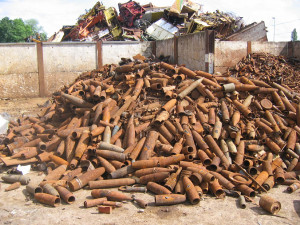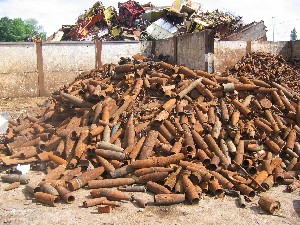In a holding centre for ordinary industrial waste and metal waste, a 155-mm shell from World War I not fully inert and still containing between 2 and 4 kg of picric acid (melinite or 2,4,6-Trinitrophenol) exploded around 3:30 pm when a subcontractor punctured the shell with a blowtorch. An employee taking a break 10 m away died from the shockwave reflected off the walls, 2 workers were injured (one of whom seriously) and 2 others entered a state of shock. In addition to the subcontractor killed upon perforating the shell, two other workers employed by the same firm also sustained injuries.
Approximately 20 g of product had violently ignited: shell debris was dispersed both on the site and beyond the perimeter at distances of up to 300 m. The remainder of the picric acid spread over the ground (forming a yellow powder).
Emergency rescue teams and the land mine removal service were both notified. The pile of shells was sprinkled with water. A 200-m safety perimeter was set up onsite around the stockpile containing several thousand shells presumed to be inert. The adjoining street was closed to traffic, and 30 employees from a neighbouring company’s premises were evacuated.
The mine removal team conducted a site survey and ruled out any chemical risk, yet acknowledged the eventual presence of other shells still “active”, though without suggesting any immediate risk. Their findings led to maintaining constant monitoring of the site during the time required to carry out further investigations.
Another worker had already been slightly injured the very same morning following the explosion of a small-sized shell.
A prefectural order to enact emergency measures required: defining and marking a safety perimeter around the shell stockpile, applying access restrictions inside this perimeter, controlling water quality, discharging the water trapped as a result of actions taken by the emergency services team, submitting an accident report that mentioned the circumstances and causes of the accident as well as its effects on individuals and the environment, the measures adopted or anticipated to avoid a similar accident and the actions implemented to cleanup the site.
The classified facilities inspectorate recorded the facts surrounding the accident, in addition to the noncompliance with several prescriptions set forth in the prefectural order granting authorisations to the facility, namely:
– onsite presence of at least one type of explosive waste,
– failure to procure a burning permit for operations performed using a blowtorch,
– lack of training and certification verification for personnel working onsite,
– failure to furnish accreditation for the subcontracted company,
– decision to pursue the activity subsequent to the explosion that took place the very same morning, without first notifying the appropriate authorities (i.e. mine removal unit or local gendarmerie), even though an explosive device had been found onsite.
On 18/04/2012, both the company and its sub-contractor were fined respectively 100,000 and 10,000 euros, the site director and manager were sentenced to 6 and 18 months suspended sentence and 80,000 euros in damages are to be paid to the victim’s parents.
Download the detailed report in .pdf format (1.5 Mb)





